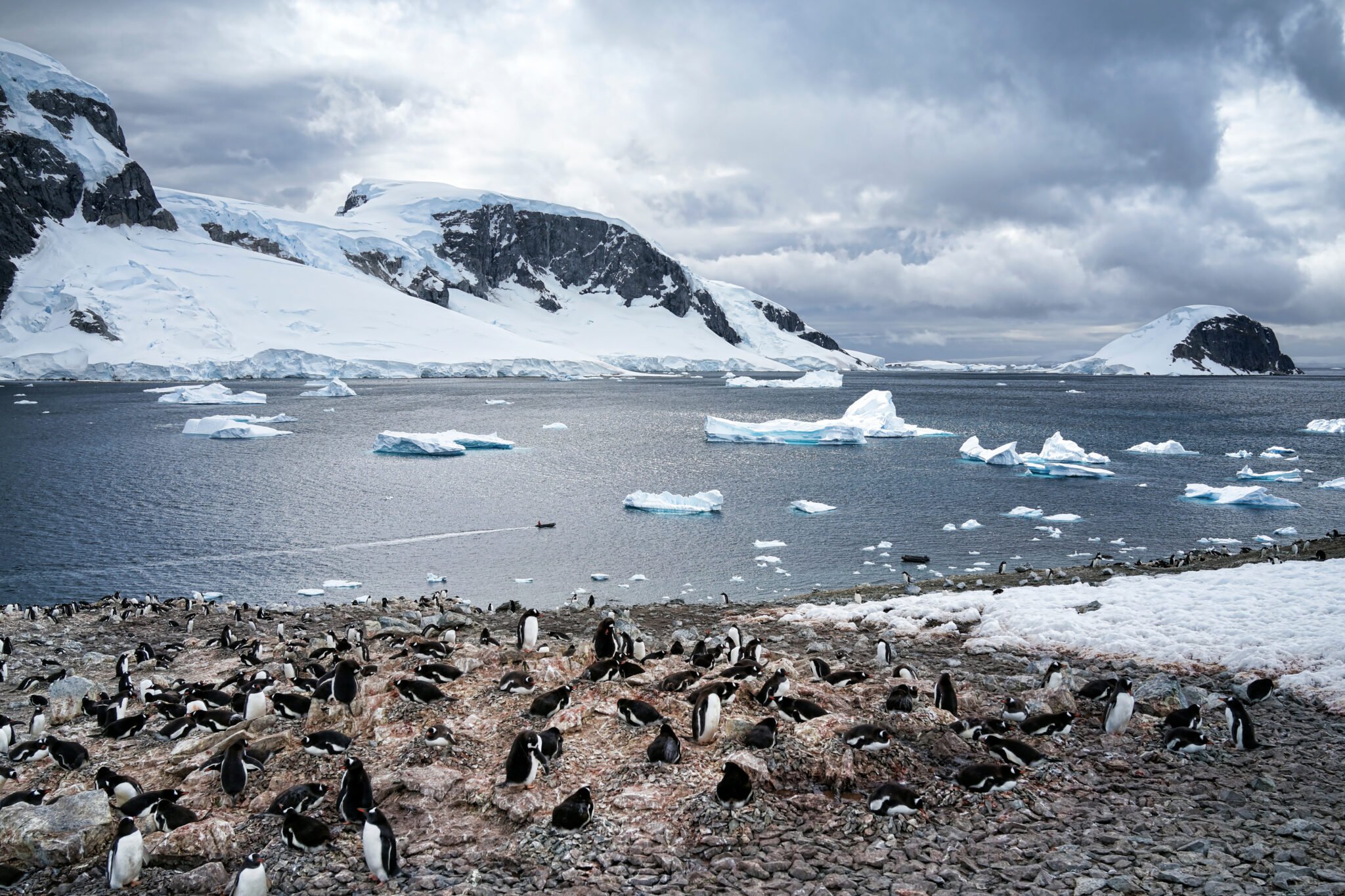Men wanted, for a hazardous journey, small wages, bitter cold, long months of complete darkness, constant danger, safe return doubtful, honor, and recognition in case of success. Ernest Shackleton 4 Burlington St. (Shackleton ad seeking crew for the Antarctic expedition in 1900)
It was 6:00 am on our third day after leaving the port of Ushuaia, Argentina, bound for Antarctica, when Captain Etienne Garcia strode into the ship’s bridge in a bathrobe and sunglasses. We had arrived at Antarctica’s Crystal Sound and “the ice.” He was excited to be there, as was I. As he’s in charge of Le Commandant Charcot (LCC), Ponant Cruise Line’s ice-breaking flagship, he had seen this ice a hundred times. This was my first, but I saw his excitement was real. He commented in French-accented English, “We are here and what a smooth journey, no? The Drake [Passage] was like a lake.” I have 11 more days of adventure ahead. We will see how smooth those are.


For over forty years, the exploration of the Earth’s southernmost continent has fascinated me. The endurance of unimaginable hardships: bitter cold, total darkness, sensory deprivation, nutritional privation, and the real possibility of crippling illness and/or death, has jarred me out of my urban comfort zone. The organization, provisioning, ship handling, and navigation required for each journey south stimulated me to think about humanity’s relentless quest for progress in the most extreme climate on earth.
As I sail aboard LCC, I swim in her pool, enjoy the sauna and snow room, and get a massage. I eat in her Alain Ducasse restaurant, followed by an espresso in the observation lounge while watching ice floes, whales, penguins, and seals. I attend the daily naturalists’ lectures and excursion updates before retreating to my comfortable Scandinavian-style cabin outfitted with every amenity. With all these luxuries at my fingertips, contrasted by my knowledge of the historical hardships of this journey, I can’t help but be overwhelmed by the technical, social, and economic progress humankind has made.
It was established early on that Antarctic exploration, aside from harvesting whale oil and seal skins, would result in no economic value. The continent is an ice desert. Larger than the United States, the dominant feature is ice, ice, and more ice. There are scores of different types of ice. Frazil, Nilas, and Pancake are just three. There is ice on mountains, ice on flatlands, rivers, valleys, volcanoes, and floating on the seas. Ice covers 99.6% of the surface, rising to the height of three miles in places. 70% of the world’s freshwater is locked up in that ice. Unlike the Arctic North Pole, which is a floating ice cap—a remnant of the glacial ice that once covered “snowball earth”—Antarctica has land underneath the ice. As one of the shipboard naturalists explained, “Antarctica was, 550 million years ago, part of the Earth’s one unified continent called Gondwana. Over eons, it migrated south to the coldest part of the planet. The climate is always evolving. It’s hard to believe dinosaurs once walked here before it went south.”


The first to discover the rumored continent was British explorer James Cook in his 1772-75 voyage. He observed and sailed around the ice shelves, believed the land itself was impenetrable, and wrote, “The risk one runs in exploring a coast in these unknown and Icy Seas, is so very great, that I can be bold to say no man will ever venture farther than I have done…” Not a very promising call to later explorers. However, since his journals revealed wildlife in abundance, within a few decades, a century-long mad rush of whalers and sealers came to relentlessly kill everything that breathed.
Cook’s discovery set in motion an era of scientific exploration, as large expeditions, led by adventurers and scientists sailed in uncharted and perilous waters, mapping the continent’s shores and islands.
The next big wave of interest came in 1874 when astronomers studying the transit of Venus ventured south. This became the catalyst for inter-European rivalry, as countries sent scientists and explorers to Antarctica. Belgium, France, England, and Germany all competed to go the furthest south and winter over the longest. These were huge expeditions requiring years of planning, funding, and provisioning. Both national treasuries and private sponsorships were used. Temporary land bases were established and dashes to the pole were set in motion. Public buy-in was essential, so when the adventurers returned, they toured lecture halls and wrote countless newspaper accounts, emphasizing the hardships of life on the ice, their frozen bodies, the relentless darkness of winter, and the perils of migrating ice shelves. They enthralled audiences living in a world that was becoming urban and sedentary.
Sir Ernest Shackleton, however, stands in the English-speaking public’s mind as the most notable adventurist of all, probably because, by this time (1914), mass communication was possible. As many know, Shackleton’s voyage on the Endurance (recently found almost intact after 106 years at the bottom of the Weddell Sea) ended in disaster. His ship was caught in the ice during the long winter and had to be abandoned. Using lifeboats, Shackleton led his 27 men to safety on Elephant Island. Then he and a few others underwent a harrowing voyage to South Georgia Island and eventual rescue. No other Antarctic explorer ever captured the public’s attention like he did, not even Robert Scott, who died on his Terra Nova expedition, or Roald Amundsen, who was the first to reach the pole and return alive.
As timelines go, Shackleton’s historic voyage 110 years ago is both distant and near. Distant in the sense that we have gone to the moon several times since then and have GPS on our cell phones. Technology has progressed so rapidly that the “modern” Antarctic explorers—Shackleton, Scott, and Amundsen—seem closer to James Cook’s discovery of Antarctica in the late 18th century than to our routine visits to this ice-covered land today.
While the derring-do of the above remains in the imagination of those interested in polar adventure, it is a quieter man, a man primarily interested in science, that the Antarctic adventure ship I was on was named after—French doctor and explorer Jean-Baptiste Charcot. His twentieth-century expeditions discovered and mapped over 600 miles of coastline which he explained in 18 volumes of scientific reports. Robert Scott called him “the polar gentleman.” Our voyage on LCC visited several islands and harbors named by or for him.
The South Pole explorers of yore were envelope pushers; they lived and died mapping and naming the vast continent’s features.
Ponant’s Antarctic adventurers will have a different experience than past ones. Here are some of the contrasts.

Scope of Exploration
Very few people going to Antarctica understand that they only see the Antarctic Peninsula. One of the LCC naturalists explained, “They’re seeing less than 1% of the land mass.” Fortunately, this peninsula is closest to the ports of embarkation (in Argentina and Chile), has most of the wildlife, and is the most accessible place to land. The other 99% is hard to access and far more monolithic in terms of visuals—often just a massive ice shelf. One, the Ross, is larger than France, a scale difficult to comprehend.
Weather
Another misconception is the weather. My friends asked me how cold it was. They imagined freezing, life-threatening, sub-zero readings with accompanying whiteouts. Unlike the real explorers, no cruise ships go to Antarctica in the polar winter. We sailed in the polar summer. Some days it was hot, in the 50s, with brilliant sunshine, 24 hours’ worth by the way. Most days it was in the 30s. Yes, there can be storms and high winds, but they are the exception, and modern forecasting prevents anyone from being caught out in life-threatening conditions.
Navigation
GPS is so accurate that a ship’s officer can pinpoint their location within a few feet on a chart. Depth, ocean bottom contour, water temperature, and even ice floes appear on computer screens. The LCC’s bridge never had less than three officers tracking and plotting our course. Thus, we could sail in the icy waters called The Gullet, a very narrow 11-mile channel. Just to be sure, our helicopter scouted the route before. It deemed it passable, a feat unimaginable to those in wooden ships taking occasional sun sights and using sounding lines to (hopefully) tell them where they were.

Propulsion
The LCC uses the most advanced propulsion systems. The famed Norwegian shipyard, Vard, built her with engines that can run on diesel, liquefied natural gas, or self-charged batteries. Two Azipod rotating propellers allow the ship to not only enter the icepack but back out of it. Using these Azipods, LCC can secure itself into the ice for passenger disembarkment. The days of relying on winds or coal-fired engines for propulsion are over. In an impressive feat of technology, LCC schedules its return hour to Ushuaia based on winds, tides, and ice with complete accuracy.
Communication
I have always been amazed that even though Shackleton set out in the 20th century, he could reach no one when he got caught in the ice. The world didn’t know the Endurance sank or that he left 22 men on Elephant Island when he started the most incredible small boat journey ever undertaken—to South Georgia Island—to find help for his stranded crew. As we used our Instagram accounts to update everyone, let’s just say I wished Sir Ernest was watching.
Provisions
Scott and others ate pemmican (dehydrated ground meat mixed with fat). They often mixed in biscuits to prepare a dish called “hoosh.” When they ran out of that, they starved or went locavore by roasting penguins or when pushed…their dogs. Explorers’ diets were geared toward survival, not pleasure.
The legendary French chef Alain Ducasse is the culinary director for Ponant, and his imprimatur is on NUNA, one of LCC’s two restaurants. So, while viewing the ice, mountains, and wildlife from the picturesque windows in the dining rooms, one can sip vintage wine selected by the two sommeliers, eat foie gras and sweetbreads, or graze from the perpetual buffet on another deck. I did a few silent toasts to the pemmican eaters of yesteryear, imagining what they would think when our concern was about putting on weight, rather than rationing calories to last through the winter or consuming the vitamins necessary to prevent scurvy. As executive chef Florent Delfortrie explained, “Since everyone’s onboard for 12 days, our desire is to provide as varied and rich a culinary experience as possible, from a healthy vegetable-focused meal to a French fine dining one. Our chefs create traditional Indian meals too.”
The observation deck’s espresso/wine/snack bar was my go-to place. I luxuriated for hours in this beautifully decorated space, taking in my stunning surroundings.
Danger
Back then, it was understood adventurers might return with frostbite, snow blindness, or not at all. Now, save for a few very rare headlines, Antarctic travel is as safe as driving to your Auntie’s an hour away. All ships have rigid guidelines supervised by IAATO, the International Association of Antarctic Tour Operators. As an LCC engineer put it, “Theirs is the baseline for ship safety and environmental care. We go way beyond their requirements. For example, we custom-engineered our own lifeboats and ice shelf survival systems. Fortunately, we’ve never had to use them because this ship is Ice Class II, built to withstand anything that could be thrown her way.”
Captain Cook’s vision was limited to his primitive telescope’s capabilities. Often, our expedition leader, the soft-spoken and intensely focused outdoor guru Steve Moir, scouted our intended landing sites by helicopter, confirming they were feasible. Since LCC goes where other ships cannot, our destinations were bespoke. Other ships often must wait their turn to get onto the ice or the continent. As we were alone and further south, the itinerary demanded a higher level of planning. Steve said Ponant’s primary goal is, “Exploration beyond expedition,” which explains the captain’s desire to see bays and inlets for the first time.
Who’s Aboard
“Rugged men of adventure with nautical skills,” mechanics, riggers, and carpenters, plus dog handlers and cooks, were the crew on explorer ships of old. They had to be tough as nails to survive the harrowing environment. Dog handling is not required of today’s LCC passengers, who can be divided into three groups.
Cruise Aficionados
They have been everywhere else (like Alaska…. three times) and want to check off a new box on their bucket list. This group is very loyal to Ponant and so were excited to be aboard a new state-of-the-art luxury ice class ship. One couple I met who love to travel explained, “Of all the trips we have ever taken, this is by far the most adventuresome. We never take ‘beaten-path’ vacations.”
Photography Buffs
Every other neck had a few thousand dollars of digital SLRs dangling from it. Cameras mounted on tripods for penguin close-ups appeared on the ice like mushrooms after a rain. Sue Flood, an award-winning BBC photographer, and her business partner Ian Dawson were the ship’s “photo ambassadors.” They offered tips, gave critiques, and held a photo contest for all the shutterbugs.
Wildlife Lovers
I had no idea penguins could elicit the responses they did, maybe because I never saw the film “March of The Penguins.” We encountered four different types, often up close, including the majestic Emperor. These meetups really made people’s day. Excitement at the varied birdlife rippled through the wildlife-loving passengers as well. The Elephant Seals and their unconventional sexual mores were another story, evoking more curiosity than affection.
For the entire naturalist crew, the captain, his officers, and myself, the once-in-a-lifetime highlight was watching a line of 100 feeding humpback whales. The captain stopped the ship and for over an hour we watched them dive and surface, their blowholes creating geysers of spray. We were close enough to hear them communicate with each other.
The 19 explorer-naturalist guides won my head and heart. To meet and get to know youngish 27–40-year-olds devoting themselves to climatology, glaciology, geology, ornithology, and marine biology was, frankly, inspiring. When not working for Ponant, they live in remote places, cobble together gigs like kayak adventures in arctic Sweden, or work on nature documentaries. Each one was an expert. Their daily lectures were eagerly anticipated, as was the late afternoon debrief of what we experienced on the ice with accompanying professionally taken photos.
Ponant strongly encouraged all passengers to “take an explorer/naturalist to dinner.” I did so several times and had stimulating conversations about the warming oceans, the geopolitics of Antarctica, and the habits of the wildlife. These guides were smart and inspirational, and not headed to investment banking. Instead, they helped us contort our bodies into survival suits for the kayak trips and led us safely into the Zodiacs for closeup interactions with the wondrous, sculpted wind-carved ice floes.
The LCC also always has visiting scientific researchers aboard who work in fully equipped wet and dry labs. In collaboration with international scientific bodies, they sample ocean waters, looking for microplastics, and study the health of the marine ecosystem starting with krill, the base of the ocean’s food chain.

Accommodations and Amenities
Smoky, stinky, dark, and fetid would be a fair description of Antarctic exploration before our modern era. Older expeditions often utilized dogs and, unwisely, horses, to take them onto the ice. In winter, the dogs shared the crew’s living quarters.
Entertainment was a necessary amenity on ships of old because one of the paramount shipboard concerns was madness. It was the captain’s responsibility to provide distractions.
There was no possibility of boredom-induced madness on our ship. We had so many scheduled activities that conflicting events necessitated making ranked choices. Should I go to yoga or the ice lecture? Go to the whiskey tasting or get a massage? The Daily Program updated us on our geographic goals, weather forecasts, and off-ship excursion possibilities. A chime alerting us to an announcement from the captain or cruise manager, Simone, sounded a few times a day. Like a medieval church bell 2.0, it told us to pay attention to some scheduled event or a wildlife sighting deemed worthy.
As in all great explorations, the captain played the central role. Etienne Garcia was informative, humorous, gracious, and reassuring. Clearly, Ponant’s double-digit billionaire owner Francois Pinault has given him a free hand to, as Garcia said, “go where nobody else can. I’m in touch with my vessel, and she loves being in the ice.” If you doubt this, track LCC on Ponant’s site and see where she has been. The geographic North Pole was her pre-commissioning shakedown cruise!

A Word About Antarctic Travel
There are more Antarctic adventure seekers every year. However, they represent 0.4% of all cruise passengers (100,000 vs. 25,000,000). Antarctic ships are highly regulated by the IAATO and must comply with The Antarctic Treaty, signed by 52 countries. Also, as mentioned before, the volume of the landmass visited is insignificant, so the continent remains untouched. Plus, no waste can be discharged, and all shore excursions follow strictly enforced protocols to protect wildlife.
The world’s oceans are warming at a record rate, and the seas surrounding the Antarctic Convergence are no exception, but this is from the world’s energy use, not from these few cruise ships. Many of the naturalists aboard saw Antarctic travel in a positive light. They hoped visitors would become “Antarctic ambassadors” and join the worldwide effort to keep it as pristine as it is. Ponant ships are all Clean Ship Super-Certified and earned a North American Green Alliance certificate. They have practiced responsible tourism for 30 years, partly by offsetting carbon emissions.
There is humility to an Antarctic voyage like this one. A sense of wonder about past adventurers like Shackleton and Charcot, who explored and reported on this vast icy continent and its surrounding frigid seas. The landscape is overwhelming; the ice glistening off craggy mountains and floating on the waters is unlike anywhere else. How humans built ships that now take us to this polar wonder in safety and luxury instills in me a sense of awe at the technological progress we have made in a tiny timespan.
And I was fortunate to be guided by authentic people following in the footsteps of those who sailed before. No adventure could ask for more.















